The Fisher Body Craftsmans Guild
An Unusual Find With a Lot of History
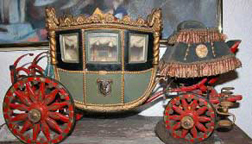
The Fisher Body Craftsmans Guild
One Twelfth Scale Napoleonic Coach
Click to Enlarge

In 1920, Henry Ford OWNED the US automobile market, because he could make the Model T much cheaper than anyone else could make cars. This was achieved by standardization, ruthless labor practices, and efficiencies in his plant. General Motors was formed out of Ford’s competition and planned to offer autos with “Styling”, tapping the upscale market. The only problem was that there were no “auto stylists.” Thus, GM bought Fisher Body, a firm that manufactured pricey carriages. However, Fisher found that it needed LOTS of employees with artistic skills. By the 1930s, GM introduced the Fisher Body Craftsmans Guild as a mechanism for finding talented workers. This was a model-building competition open to youth aged 14 to 19. The prize was a full college scholarship and a guaranteed job with GM. At the height of the depression, this was a magnificent prize.

Join Us on Facebook
So what does this have to do with Swing Dancing? (Those of you who came here from a search engine should know that this is primarily a dance website...) Actually, the question should be "Why was a Fisher Body Craftsmans Guild competition entry sitting in the bulk trash in Chevy Chase?"
My acquaintance with the Fisher Body Craftsmans Guild began (as do many of the stories here) on Bulk Trash Day, September 2005. This day was particularly fruitful, since one of the older houses had turned over and the new yuppie owners were anxious to turn it into a McMansion, granite counters, stainless steel refrigerator, Great Room and the like. Generally these Phillistines are in such a hurry that they throw out all kinds of valuable items. Of note was a filthy old box that looked like it had been in an attic for a long, long time. Of note, it was carefully closed with recessed screws. Believing that nothing worthless ever gets this much packaging, I placed the box in the back of the PT Cruiser and took it home for further examination. It was not only dirty, but quite heavy.
After moving the item into the workshop, I began a forensic examination of the box. A paintbrush removed enough dirt from the label to determine that this was a Model Napoleonic Coach, or at least the box for one.
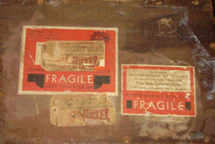
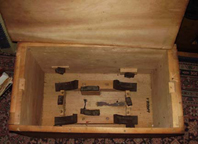
Exterior and Interior of the Shipping Box

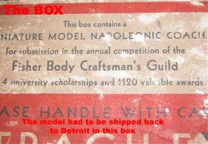
Shipping label
The Model Had to Survive the Trip to Detroit...
Click to Enlarge
Prior to opening this treasure, I did a little search to find out what might be in the box. Lo and behold, there is actually a Museum devoted to the Fisher Body Craftsmans Guild! This is the authoritative source, so check it out. The rest of this page is devoted to my own dabbling in the history of the Fisher Body Craftsmans Guild.
With some anticipation, I carefully removed the screws to expose the contents. Indeed, they were marvelous!
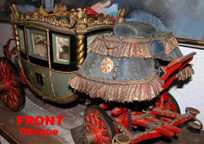
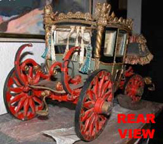
Front and Rear Views of the Napoleonic Coach
Click to Enlarge
General Motors sponsored a contest with an astounding amount of prize money ($80,000 in 1934 is equvalent to about $2.5 million in 2011). Individual winners got scholarships worth $5,000 (equivalent to about $150,000 in 2011). Eventually, the competition also had a devision for automobile design.
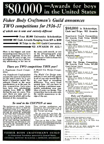
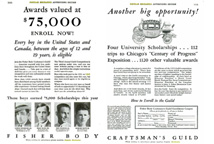
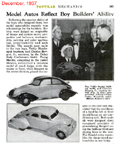
Ads for the Fisher Body Guild Competition
Click to Enlarge
The competition required the entrants to build a 1/12 scale model of Napoleon’s coronation coach (which also was Fisher Body's trademark.) The contestant received 19 pages of plans and nothing else. After spending about 2000 hours, the kids came up with something like the coach in the pictures. In theory, all of this - metal, wood, fabric and glass parts were all made by hand.

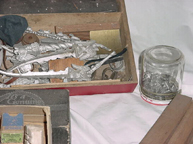
Hard to Make Metal Parts supplied by GM in the Starter Kit
Click to Enlarge
To stimulate interest, GM made available a "starter kit" that had a lot of the more difficult to make metal parts, such as the imperial eagles on the corners and the finely detailed trim., although the highest points were awarded to those who made as much of the coach from scratch. Thus, the successful entrant had to be skilled in all of fields necessary for work at Fisher Body.
Of some note, the product PLastic Wood was being introduced into the marketplace. This is a mixture of sawdust and a solvent-based glue that, as its name indicates, can be formed into almost any shape that is desired. Initially, it was hyped as a major aid to modeling -- in fact, the Plastic Wood folks managed to get endorsements from several of the original coach contest winners. General Motors promptly put a stop to this...

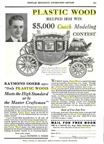

Plastic Wood and the Fisher Body Guild Competition
Click to Enlarge
We have compiled a number of ads that tout the usefulness of Plastic Wood in making models. (Click here to download a ".pdf" of these ads). Personally, I could not use this product in modeling because it is too difficult to work with -- maybe the formulation was different in the 1930s. Today it is mainly used to fill nail holes.
During my research, I acquired a copy of the plans and scanned them. If you would like to match wits with the 14-year olds of 1931, contact me and I will be glad to send you a ".pdf"of the original plans. (it is about 5.1 MB, so it would help if you had a fast connection and a big mailbox!)

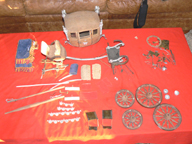
Partially Constructed Napoleonic Coaches
Click to Enlarge
Occasionally, estate sales offer coaches in partial stages of completion. My guess is that if a boy started this project, he may not have finished it, but he would never forget it and save the pieces forever. Thanks to our friend and real-live Guildsman Jeff, we have obtained pictures of some coaches under construction. This offers a good chance to show some of the work that was done alongside the actual plans.

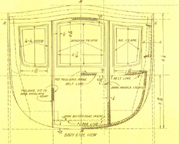
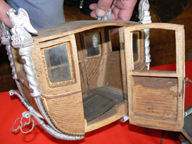
Coach Body and Door
Click to Enlarge


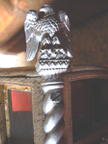
Specifications for Ornament and use of Stock Parts
Click to Enlarge
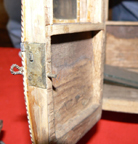

Model and Plan Specifications for Working Lock
Click to Enlarge
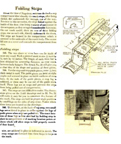
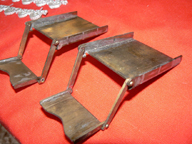
Model and Plan Sppecifications for Retractable Folding Steps
Click to Enlarge
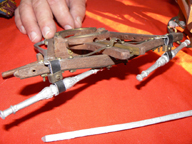

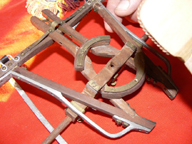
Model and Plan Specifications for the Coach Steering Pivot
Click to Enlarge


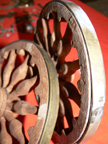
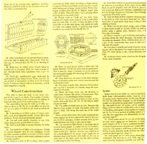
Model and Plan Specifications for Wheels and Ornament on the Footman's Board
Click to Enlarge
There were two prizes for every state and a grand national winner. The coach that I found won second prize in Wyoming, so you can get an idea of how intense the competition was. The shipping box was itself a wonder of craftsmanship; no matter how good the coach was, it had to arrive intact in Detroit before it could be judged.
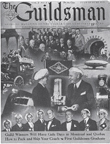
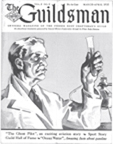
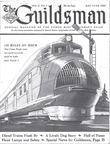
Excerpts from The Guildsman, Official Magazine of the Fisher Body Craftsman's Guild
Left: How-to-Make-It Tips
Middle: Article on the importance of Gasoline
Right: Article on Streamlined Trains
Click to Read the Article as a .pdf
In addition too the plans and a nifty membership card (see below), participating in the contest got you a subscription to The Guildsman, a slick magazine that mixed news, sports, ads for GM products and craftsmanship. Above are three excerpts from the magazine, dealing with topics of interest to Boys, such as Gasoline, Streamlined Trains, and Model making tips. Click on the cover to read the articles.
Here are some of the details.
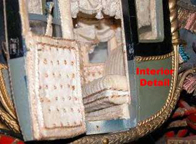
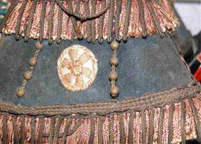
The Interior and the Driver's Stage
The upholstery was tufted and the windows had to work!
All the braids had to be woven, mixing thread and gold wire
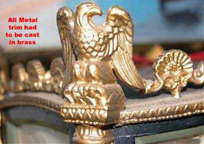
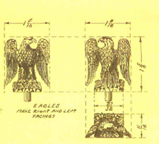
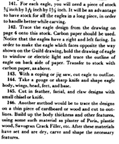
The Corner Eagles -- Example of metalwork
Contestants were urged to fabricate these from scratch --
although a "Helper Kit" was available
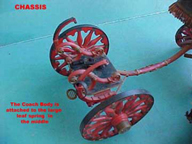
The Chassis The chassis and leaf springs had to be fabricated from stock!
Click to Enlarge
One of my readers, Jeff (an Actual Guildsman!!) had some comments about the degree to which the Guildsman who made my coach fabricated things from scratch. In the following photo, he compared the Corner Eagles on my coach with those on other coaches that are known to have used "stock" parts.
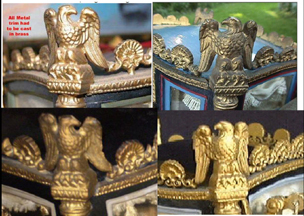
Were the Corner Eagles Made from Scratch?
My coach is in the upper left hand corner
Click to Enlarge (You really need to do that...)
Jeff Says:
"... [after] studying that close-up picture [of your model] I am 99.99% sure those are the GM supplied parts. I study these things with a very critical eye (have a directory with hundreds of guild model detail photos 'just in case'!) and have NEVER seen a coach w/ home-made fittings. Yours have all the characteristics of the stock items including signs of the factory flashing and the 'soft' etching details which I believe would be quite different in a home made version. I attached a collage of your eagle with another left handed one and two right handed ones from my picture files. As you can see, the details are virtually identical and I submit that they must be, a) painted GM pot metal stock items, b) brass castings made from molds taken from the original pot metal, in which case yours should be measurably smaller, not larger, than the reference ones due to metal shrinkage associated with the casting process, or c) he had an example of the GM items and was a MASTER carver/engraver to be able to make a virtually exact copy. ...if you look at the GM working drawing of the eagle.., there is NO WAY you could duplicate the pot metal one so closely from that drawing. Take it from me, that is HARD to do even when you have the original sitting right there in front of you!! ..."
My only rebuttal to Jeff was the fact that the coach that I found apparently won some medals. Here is a photo as they were found:
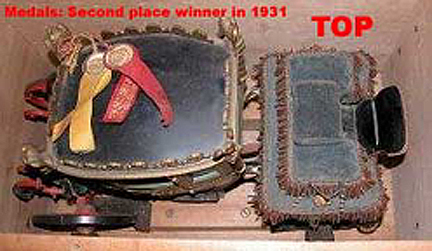
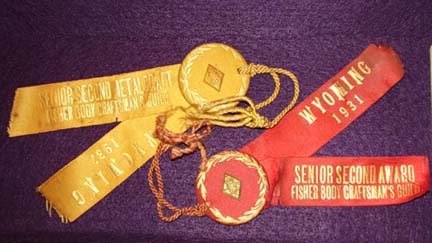
The Medals
Yellow: Senior Second Metal Craft, Wyoming, 1932
Red: Senior Second Award, Wyoming 1931
Click to Enlarge
Since the coach won a price for metalwork, it might be reasonable to assume that the trim, including the eagles, was made from scratch.
Jeff says that this is not necessarily so:
"... If you study your coach, you will see a ton of work had to be done even to get the supplied parts into presentable condition. As you can see in the pictures in the collage, if the craftsman didn't do a lot of filing and touch-up the result was pretty crude. The supplied casting were for the eagles, filigree around the top, coachman standards on the back step, "F" shield on the doors, wheel hub covers, wheel decorations and chassis keel. There were still a lot of parts that had to be hand crafted like the fold-out foot step under the doors, door latches, the twisted wire trim, all the metal fittings on the trucks, etc. I can see giving an award for exceptional work on all that stuff....
". ..There were awards in "Woodcraft", "Trimcraft", "Metalcraft" and "Paintcraft" for the participant. I never competed in the coach competition but this letter tells me that each coach was judged in at least those four categories and the ones representing better craftsmanship were awarded ribbons....
Recently (November, 2010) we got these astounding photos from our reader Rick, who says:
"... Enclosed are pictures of my granddads handywork. He was so talented with carving and I want everyone to enjoy his work..."
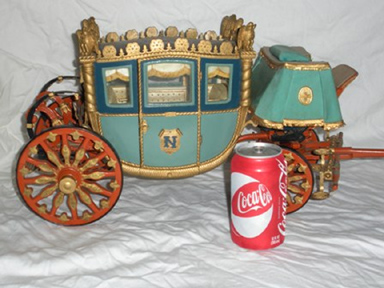
Behold the Masterpiece!
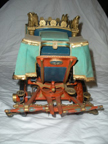
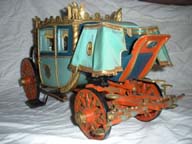
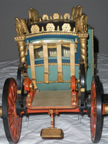
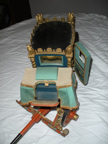
Coming and Going
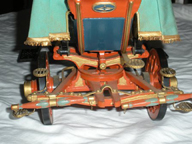
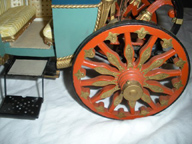
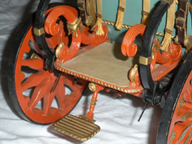
Axles, Wheels, Folding Step
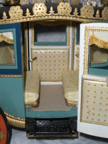
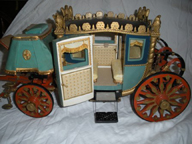

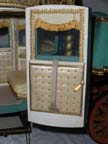
Upholstery and Working Door Locks
Click to Enlarge
I think that Rick provides the final word to Jeff about hand-carving those eagles:
"...Next I would like you to see a closeup of some of the eagles (perhaps as many as 50 were made) that were rejected by granddad for the final finished Fischer coach. Notice the pencil marks on the one wing that he used as a guide..."
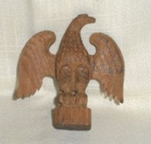
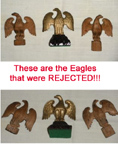
These are the eagles that were rejected!
Click to Enlarge
If that were not enough, Rick ends his note with this astounding piece of caring:
"...Here is a photo (slightly blurred) of a boat (with a man on deck), carved from a peach pit. ..."
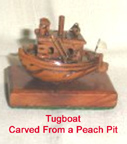
Tugboat Carved From a Peach Pit
Click to Enlarge
I am sure that you will agree that this is an excellent Napoleonic Coach. It is just spectacular, although the coach has a "historically accurate" monogram for Napoleon ("N") on the door rather than the Fisher trademark "F". I don't think that distracts from the beauty of the coach or from its craftsmanship. (The judges at Fisher Body may have had another opinion...) On the other hand, we don't really authenticate these things -- I am just a guy who found an abandoned coach and got interested in the details. I suspect that this coach is "valuable" but I would not be able to put a dollar value on it. I am not a professional appraiser. That said, Rick's coach is very nice and deserves to be seen by the public. When he asked me about value, I said that the thing should be in a museum somewhere, and failing that, should be evaluated by a major auction house. (That would be my advice to anyone who writes in about values.)
The debate about "scratch-built parts" was also joined by Skip who owns 28 coaches, and is in a position to know... He says:
"... In my collection of 28 Fisher Body Craftsman's Guild models I have several that are 'scratch built' and no 'kit' parts were used. One of them is a 1932 FBCG national winner and the other is a 1934 FBCG national winner. Both coach models are not only completely scratch built but the trim work, especially the eagles, is far superior in craftsmanship than the hard parts supplied in the coach kits. The eagles on these two models are superb!
"I have seen many other coach models that were also scratch built, and in most cases, the eagles and the trim pieces exceeded in detail the parts that were supplied in the coach kits. Among the items in my collection are two eagles that were cast by George Drummond, a 1932 national winner. These two eagles were spare eagles for his coach model. George hand carved a mold for his eagles (both left-hand and right-hand) and from that he poured a composition material into the molds to create a cast eagle. Both of these "cast" eagles are far superior, both in craftsmanship and in detail, to the cast pot metal eagles that were supplied in the coach kits. [My first photo] is a rear view of the 1932 national winning coach model built by Franz Ibisch showing the scratch built eagles and the "sea shells" on the roof...
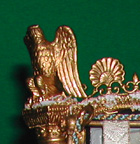

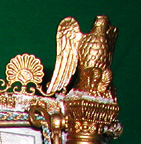
Eagle Detail from the 1932 Winning Coach Model
Franz Ibisch, Craftsman
Click to Enlarge
Skip has this to say about the "very best" coach that he has ever seen:
"...Over the last decade I have viewed at least 200 coach models, and even though some of them were unbelievable in the their craftsmanship, one model exceeds all of the others.......and that is one of the two prototype coach models made by Fisher Body at their Fleetwood factory in Pennsylvania circa 1929. That model was made by professionals and its quality in construction, craftsmanship, paint and detail in trim reflects its professional construction. The model is awesome to say the least..."
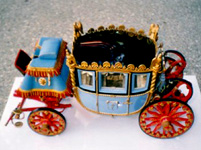
1929 Fisher Prototype Coach
Click to Enlarge
The Car Contests
Here is a copy of an actual scoring sheet from the model car era of the guild with a hypothetical Guildsman and his scores written in. This is how the sheet looked when you got it back in the mail with your car.
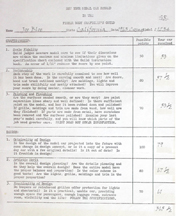

Sample Scoring Sheet for the Fisher Body Craftsmans Guild Car Contest
Also: Yearly Re-enrollment card for the Guild
you got a package of a "Designing and Building a Model Car",
the first issue of the Guildsman newspaper,
and 4 rubber wheels.Click to Enlarge
Several observations:
- As opposed to the implied craftsmanship emphasis in the Coach scoring, the car scoring sheet emphasized design (250 points total) over craftsmanship (200 points total).
- This is the actual sheet - a rough mimeographed sheet that was hand written. I would have expected a lot more sophisticated product in view of the over-the-top organization of the Guild otherwise.
- The scores shown are in the neighborhood of those that the top prize winners received! TOUGH scoring to say the least when 80% gets you in the top ranks.
- Just about everyone got 50 points for scale fidelity - all you had to do is be sure the model fit within a dimensioned box, had adequate ground clearance, etc.
I envision the coach contest had a similar scoring sheet and your guy happened to score well in the standard "Metalcraft" category, not because of making exceptional hand-made parts but because his overall craftsmanship in presenting the metal parts was above average. ..."
You might wonder: How would the pros already working at Fisher do in the contest? That question remained unaswered until 1973 when the company offered a Golden Anniversary Special model of the Napoleonic Coach doen in solid silver with gold-plated trim. About 1,000 of these were supposed to have been made, each inscribed with the owner's personal registration number (see plate on bottom). They promoted it as, "what promises to be one of the most sought after collector items ever produced in a precious metal." Here is one of these coaches that showed up in an online auction:
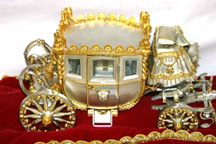

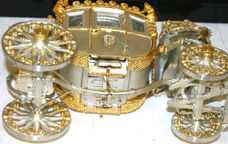
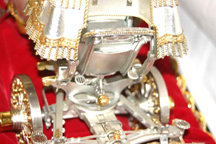

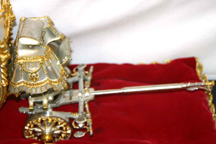
Silver Anniversary Edition of the Napoleonic Coach
Photos Courtesy of Jeff Jones, Guildsman
Click to Enlarge
Since I found the Coach, I have been doing some collecting of other artifacts related to the Guild
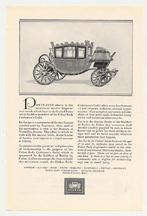
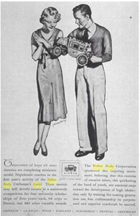
Fisher Body Advertisements
Left: The Napoleonic Coach was the Trademark of the Fisher Body Division of GM
Right: In 1931, girls [apparently] went nuts for Napoleonic Coaches...
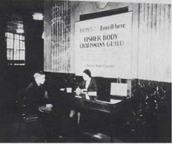
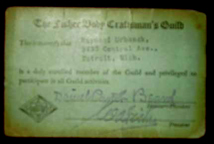
Signing Up for the Fisher Body Craftsmans Guild
The sign reads: "...an opportunity to earn your college education as well as 980 other awards..."
Taken in the Fisher Building, Detroit
Daniel Carter Beard, head of the Boy Scouts was the FBG Honorary President
Click to Enlarge
Here is an article about the Fisher Body Craftsmans Guild that I found in the TIME Magazine for August 31, 1931

TIME Magazine, August 31, 1931
That's Nelson Rockefeller's Uncle on the Cover
Click to Enlarge
Oldtimers insist that there are still carriages on the streets of Norwalk, Ohio, built by Andrew Fisher. Andrew begat Lawrence, also a wheelwright, and Lawrence begat seven sons. They were named William Andrew, Frederic John, Alfred Joseph, Charles Thomas, Edward Francis, Lawrence Peter, Howard. William Andrew was the lazy one. He would cock his hat over his eye, pretend not to see his father beckoning him into the blacksmith shop. But ultimately he and all the rest except Howard industriously followed their father's and grandfather's trade. After the turn of the century the six Brothers Fisher started Fisher Body Corp. William Andrew became president. General Motors took them in and today they are the most numerous, most affluent guild-family in the world. Partly to advertise Fisher Bodies, and partly because they relish good craftsmanship, last week they had a party.
To the Fisher party, held in the auditorium of the GM building in Detroit, went 104 boys from 48 States and the District of Columbia. They were all either junior (12 to 16) or senior (16 to 19) members of the Fisher Body Craftsman's Guild. Each had constructed a model of the Napoleonic coach which is the Fisher Body trademark. Some 1,350 other U.S. boys had built models too, but these 104 were the best. In the pocket of his Sunday suit, each boy had some part of $50 which General Motors had given him for spending money during his visit to Detroit. While Graham McNamee gushed a description of the setting over a national hookup on the General Motors Family Party radio hour, each boy wondered if he was going to be one of the four to receive a $5,000 four-year scholarship at college.
Formed last August, the Guild had sent its members specifications for the coach. Technicians had examined hundreds of models, alike to the lay observer as two peas in a pod. The judges included President Thomas Stockham Baker of Carnegie Institute of Technology; Board Chairman Robert Andrews Millikan of California Institute of Technology; Board Chairman Samuel Wesley Stratton of Massachusetts Institute of Technology; Dean Dexter Simpson Kimball of Cornell's College of Engineering and eight other engineering deans and professors. Also there was Daniel Carter Beard, national Boy Scout commissioner, who served as honorary president of the Guild, of which William Andrew Fisher is president.
President Fisher, who wanted to see what the nation's boys could do with plane, chisel, glue and mould, had sounded the Guild's keynote last year: "It is our endeavor to foster . . . that spirit of fine workmanship which permeated the craft guilds of bygone centuries. . . . There was a pride in workmanship which kept alive a competitive spirit among Guild workers, and there was a healthy rivalry between Guilds in the same industry. . . . Regardless of the advancement in machinery, there is today and will continue to be a need for real artisans and craftsmen."
Hushed was the hall when the ice cream plates were cleared away. Impressively the winners were announced. One of the senior Guildsmen had won on his home ground-Raymond S. Doerr of Battle Creek, Mich. Graduated from high school in February, he was encouraged by his father-a pattern maker for a plumbing manufacturer-to build a coach instead of looking for work. He set up a workshop in the family's basement. The other senior winner was a boy named Albert Fischer from Waukegan Ill. He was let out of his draftsman's job, spent 1,200 hours on his coach.
Howard Jennings, one of the junior scholarship winners, came from Denver, Colo., used the machinery at the printing shop where his father is a steel engraver. Donald Burnham of West Lafayette, Ind., worked at home in a little basement. An old hand at modelling, he once got a trip to Europe for making a miniature airplane.
When they have finished their college courses all the winners will be offered General Motors jobs.
The Car Design Contest
In 1937, the competition allowed entrants to choose between making a coach OR making a model car. Building the Napoleonic Coach attracted a crowd of technicians who were really good at following plans. Fisher would have wanted lots of these guys as craftsmen. BUT, the essence of the GM business plan was selling styling. I'm not sure whether the Coach brought out men of Vision -- I think that the Car contest was instituted to find forward thinkers. It was probably good to require that the Car designer actually make the model -- this would weed out a lot of fantastic confections that could never be manufactured. Over the years, the available materials have changed, permitting a variety of shapes to be made. I understand that 1920s cars look like they do because of materials availability, road clearances needed, and frame design. Similarly, I am told that streamlining was limited during the 1930s and 1940s because steel could only be pressed to a certain radius of curvature, etc, etc. I also assume that the investment in dies, tools and training favored a styling that made only small modifications, with emphasis on the easy part like sheet metal.
Here is a link to the Manual that would teach you how to make and submit your model car.
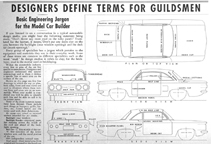
Car Styling Terminology
Throw Some Mud on that Tulip Panel...
Actually, cover that Corvair with mud...
Click to Enlarge
Thanks to Guildsman Jeff, here is a sampling of the contest rules and model-making advice that were provided to competitors in the Car Contest.

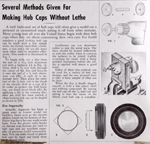

Painting and Hubcaps
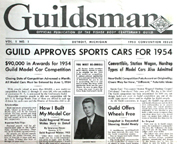

Sports Cars, Armatures and Free Wheels
Get a note from Mom, Dad or Your Principal
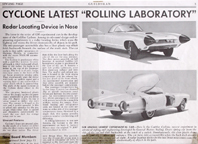
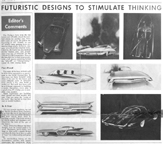
Design Inspirations
Note that the "Radar" on the Cyclone is standard issue on Mom-Friendly Volvos
Click to Enlarge
How "Advanced" was the Styling?
As you'll see below Guild winners in the 1940s look like cars from the late 1940s or early 1950s. (The 1947 winner looks a lot like the 1950 Studebaker...)
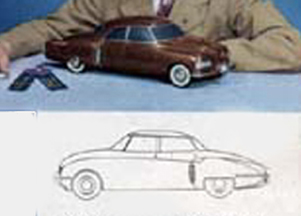
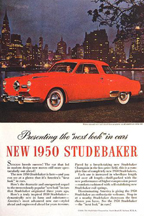
3-Year Vision
1947 Guild Winner and the 1950 Studebaker
Click to Enlarge
When Harley Earl's dream cars were shown, Guild winners start to look like airplanes or something out of the Jetsons, as shown below in some photos sent to us by our Guild expert Jeff.
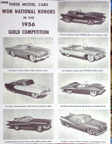
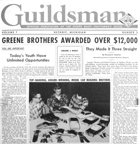
1956 and 1959 Guild Car Contest Winners
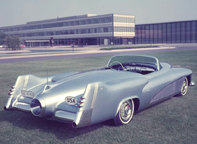
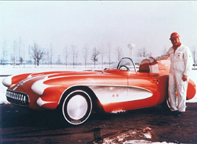
Harley Earl's Le Sabre and Corvette SR2
Click to Enlarge
On the other hand, these photos, taken from a November, 1953 issue of Popular Mechanics indicate that the executives at Hudson and Packard were no better than the kids at dreaming up the future. Both companies folded in 1954...

The Execs Had Less Vision than the Kids
1953 Hudson and Packard "Dream cars"
Click to Enlarge
I assume that GM's selection involved all the practical limitations on car design that a realistic designer should consider. So, I asked real live Guildsman Jeff about his thoughts on how much "vision" and how much "pracitcality" went into the winner of the Guild car competition. Other questions were: What was your personal design process? What about hot rodders and customizers? How much of the Guild was influenced by those guys? Did George Barris ever enter the contest?
Here's what Jeff had to say:
"... Yes 99.999% of the Guild cars reflected the Detroit cars of the day, i.e., '58 Guild entries all looked pretty much like a '57 Chevy but there was always one or two cars that stepped it up a notch or two into the future. Here are some examples:
- Click Here for a ".pdf" showing all the winners from 1948-1966
- Click Here for a ".pdf" showing the design specifications for the car contest
- Click Here for a ".pdf" of "how-to-do-it articles from The Guildsman
"...The 50s 60s hotrod/custom rod culture influence is smack on my story! Except although I really like Barris' work, Ed Roth is my car god.
The Mysterion existed about a year then it disappeared but it was the first car I saw when I quit playing with the toys at the grocery store and started reading the rod books. All my cars were influenced STRONGLY by those geniuses. In fact I am in the process of making a 1:1, driveable reproduction of his Mysterion show car (phots of the headlight pod I made attached - wood plaster model (white and wood), model finished ad ready to mold (green), 3-piece mold taken from green model (orange), and finished pod (white w/ lights installed).
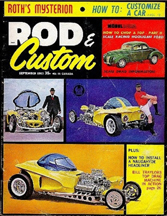
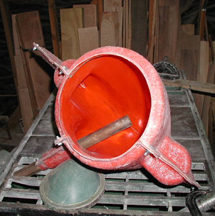
Ed Roth's Mysterion Car and Jeff's Reproduction Headlight Mold
Click to Enlarge
Your readers should get a copy of John Jacobus' book on the Fisher Body Craftsman Guild -- it's very informative. Also he is working on a possible sequel consisting of bios from couple dozen Guild alumni telling their Guild memories. I am honored at being considered for inclusion in his book as an also-ran story! I helped John get an article published in woodcarving magazine. ..."
Here are the articles -- and they are very well written:
Did Nepotism Raise its Ugly Head?
As I looked through the materials on the Car Contest, I found this 1947 article from Mechanix Illustrated that shows winners from both the Coach and the Car Divisions:
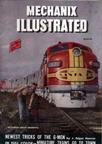



Click to Enlarge
The principal reason that I have reproduced this article is that it features a very young Virgil Exner Jr., wearing his Guild Beret. Mr. Exner, Jr. was the son of Virgil Exner, Sr. who was to rise to head the Chrysler Design Division and gave us the "Forward Look" --- all those giant cars with big tailfins. Some of the most extreme are:

The 1957 De Soto
De Soto sponsored Groucho Marx's TV program, but soon faded from the scene.
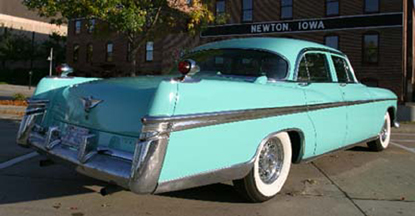
The 1956 Chrysler Imperial
I love those tail lights sitting up there - America's answer to Sputnik.

The 1960 Crown Imperial Convertible
I think that this got 4 MPG, but it could sure haul butt....
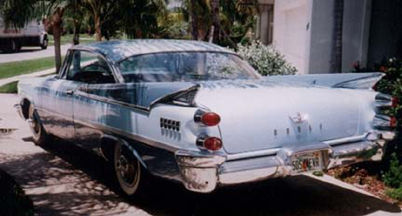
The 1960 Dodge Royal Lancer
This was a real monster for a "working class"car
Click to Enlarge
I was a little bit worried about the appropriateness of Exner, Junior entering the contest -- he had a rather large advantage over a kid from rural Wyoming. I asked Guildsman Jeff about the possibility of Nepotism. He wrote back:
"... it isn't too unfair that Virgil Jr. won a top prize. First, the judging was 100% anonymous (my cars came back w/ 5-digit serial numbers hand written on the bottom in black sharpie. I imagine they had a [lower level employee] unpacking and labeling the cars before the big buys ever saw them. Second, the contest rules stated that if a relative of a GM employee ever won an award, they awarded a duplicate to the next best car so there was never an unfair advantage. That happened several times over the years. (Actually, if I were a judge an I knew the son of a competing car company legend was entering MY contest I might be biased in the other direction. But that's just me!!) ... building a car to the standards of the Guild was REALLY TOUGH and no matter how a guy did it, odds were stacked really high against him winning anything. ..."
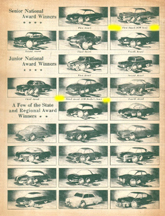
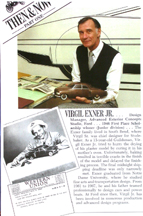
Nepotism and the Guild
Yellow marks awards given to sons of GM Employees
Exner fils turned out to be a designer after all
Click to Enlarge
I'll leave it to you: Did the Fisher Body Contest actually locate "stylists"?
I was thrilled to get the following letter and photos from Marty, one of our readers in Los Angeles:
My grandfather recently passed away and I was the very lucky person to inherit his Napoleonic Coach built back in 1933 when he was 16 years old. We have all the awards he won. Here is a photo that I took of the coach with my cellphone and a scanned snapshot of my Grandfather holding the coach at age 16
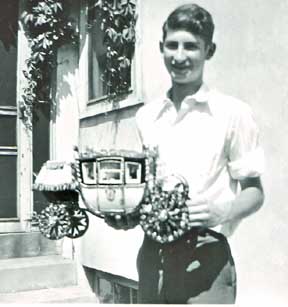
Marty's Grandfather with the Napoleonic Coach
Click Photo to Enlarge It
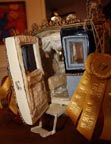
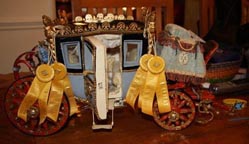




Marty's Grandfather's Napoleonic Coach
Award Letter signed by W.A. Fisher, himself.
Click Any Photo to Enlarge It
As you can tell, we have gotten a WHOLE lot of help from Guildsman Jeff. We'd like to mention that he never stopped being a painstaking craftsman. He is not an auto designer, but he IS a true master woodcarver. His work, illustrated below is just of the finest possible quality.

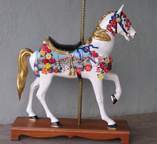
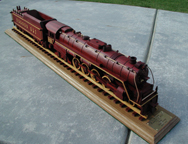
Jeff's Woodcarving Projects
Reproducing an antique table
Miniature Unicorn Carousel Figure
Scale Model of a Locomotive
Click to Enlarge
Thanks for all your help, Jeff!

Join Us on Facebook
Counter for the Entire Site (not just this page..)
Home | About Lindy | Last Week's Reviews | Upcoming Events | 1940s Collectibles
The Guide - Establishments - Travel - Accessories
Music | Links | Photo Gallery | Extras | Contact